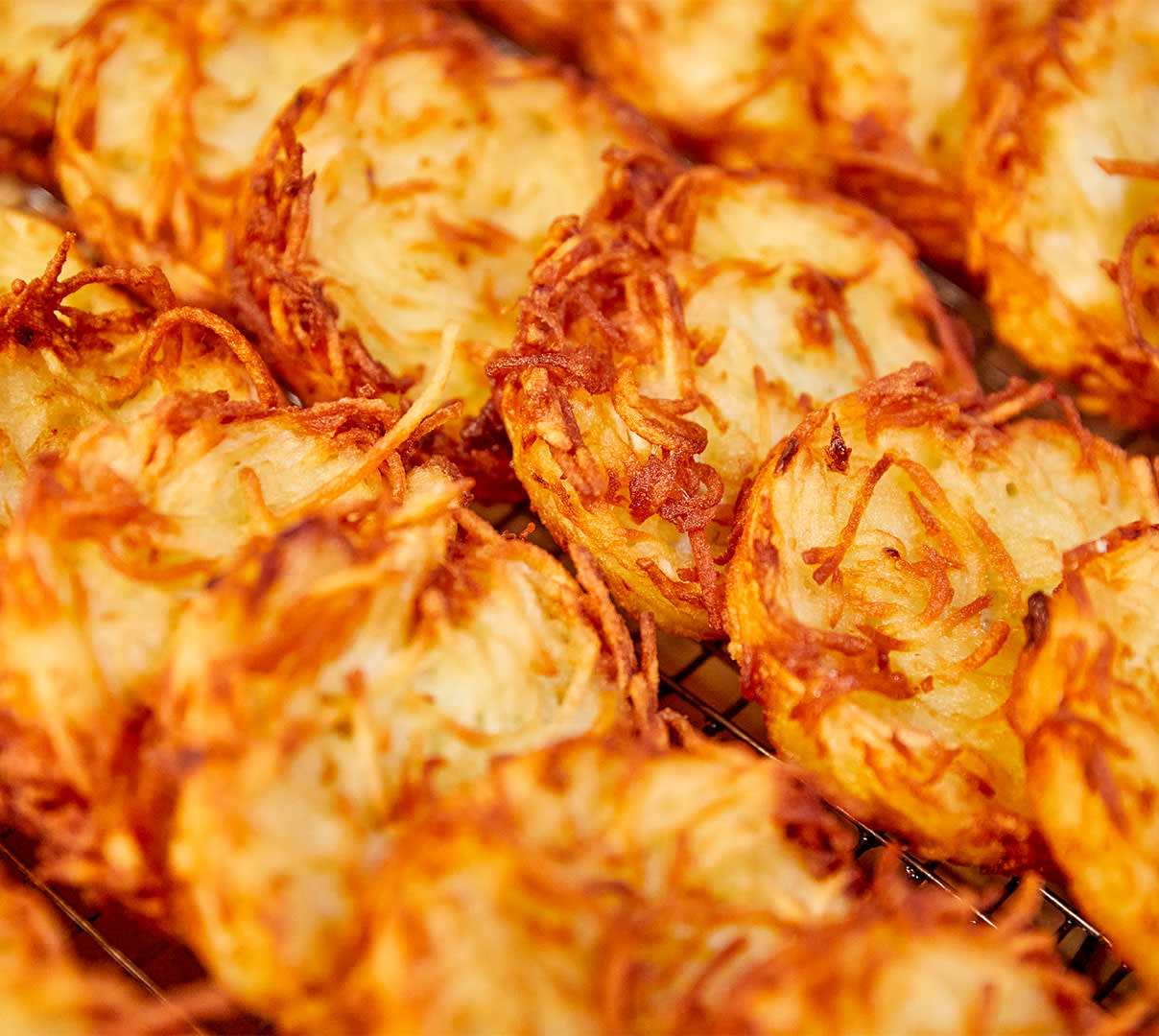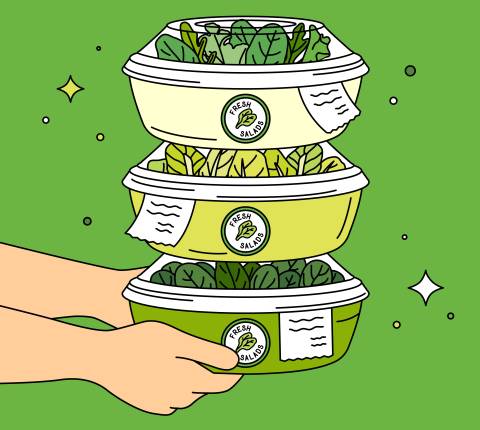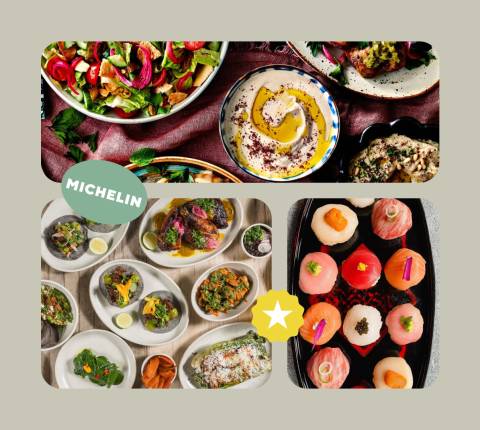*This article includes mentions of merchants or brands who are partners of DoorDash, and DoorDash may receive a commission if you choose to make a purchase from these merchants or brands.
For the past 24 years, chef Craig Stoll has been making and serving latkes each holiday season at his famed Italian restaurant, Delfina, in San Francisco. But the chef wasn’t prepared for the overwhelming demand during winter 2020, when he and his wife and restaurant partner Anne Stoll started selling them cooked and flash-frozen through his Pizzeria Delfina outposts. Between their Mission and Pacific Heights locations in San Francisco and Burlingame and Palo Alto locations, they went through more than 1,000 orders per week — until they sold out for the season. Since then, the duo has optimized kitchen operations to accommodate the annual latke demand and added the ability to order from all their locations through DoorDash — from November 27 until they sell out — with or without their now-iconic fancy fixin’s, candles, and a dreidel. Further democratizing the ability to enjoy superior latkes, the Stolls have also shared their recipe here, so now you have every opportunity to fry high through the holidays.

The Secrets to Delfina Latke Deliciousness
If you know anything about Stoll, you know his talent lies in elevating rustic dishes to new heights while keeping them humble. Case in point: his famous latkes. The recipe includes many of the well-known tricks: eliminate excess liquid from the vegetables, use potato starch as a binder, salt just before cooking to prevent the vegetables from releasing more water, and use a high-smoke-point oil. (For his ready-made latkes, Stoll’s oil of choice is rice bran for the flavor and the performance. At Delfina, latkes are fried in duck fat, unless they’re being prepared for a vegetarian diner.)
But Stoll takes it further: flash-boiling whole, unpeeled potatoes, then immediately removing them from the water and refrigerating them overnight. Sure, it’s cool that he grates the potatoes unpeeled, eliminating a step. But the real revelation is the result of the boiling: It magically eliminates the need to squeeze out even a drop of water from your grated potatoes — there’s literally no sog! — and it changes the potato texture just enough to prevent partially raw-textured centers in the finished latkes. Stoll’s game-changing hack means crunchy-creamy pancakes. Every. Single. Time. How? Harold McGee, a food-science writer and the author of On Food and Cooking, explains: “When you cook a potato this way or any way, you force the countless granules of starch to rupture — and then they absorb whatever moisture is in the vicinity. Usually we cook them to a dry fluffiness, but long before that they're sponges.”
Creating this potato pancake recipe was just the beginning. For optimal presentation, his team hand-forms each latke, measuring the amount by weight, pressing it into a ring mold, and then roughing up the edges a little bit so they’re slightly ragged. “I don’t want them to look like a perfect circle,” Stoll says.
In 2021, he also invested in an $18,000 tilt skillet, which can fry, simmer, steam, sauté, and grill, and can be tilted to bring its braising pan forward for easy food transfer. This ensures even cooking and ideally crispy-golden exteriors and velvety interiors. “We always shallow-fried latkes growing up,” Stoll says. “We did that in the restaurant, too, but then we realized more fat is always better, so we decided to deep-fry.” The tilt skillet has proven to be a great investment: It cooks up to 40 latkes at a time, holds an even temperature, and is now used to make the restaurant’s seasonal matzo ball soup broth, too.
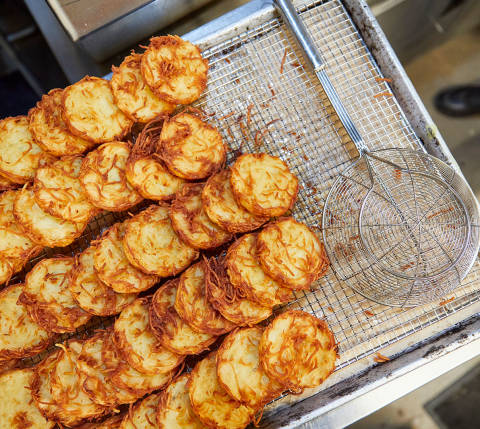
Next-Level Latke Fixin’s
Because superb latkes deserve equally outstanding sides, Stoll turned to chef Jessica Koslow of Los Angeles’s Sqirl restaurant to develop an exciting alternative to the classic applesauce. For the past few years he’s been offering her buttery-smooth Pear-Quince Conserva by the jar as an optional addition. He also partnered with Berkeley's Belfiore Cheese — which makes the mozzarella that tops his restaurants’ Neapolitan-style pizzas — to level up from the traditional accompaniment of sour cream; his own custom-created crème fraîche is sold by the tub during latke season.
Always striving to improve the offerings, this year there’s a new optional layer to the Delfina latke indulgence: Gingrass Smoked steelhead trout. Available in four-ounce packages, it’s handmade in small batches by revered chef David Gingrass of bygone award-winning San Francisco restaurants Postrio and Hawthorne Lane. “It’s better than salmon, more velvety and refined in flavor and texture,” Stoll says. This is just one more reason to extend a hearty “Thanks a latke!” to Delfina — and to order now before they sell out. But don’t worry. Once they inevitably do, you can still get a taste of latke greatness by following his recipe below.
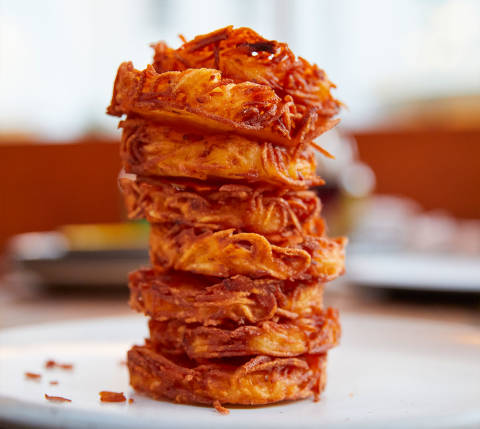
Delfina Restaurant’s Latkes Recipe
Stoll’s gluten-free, vegetarian latke recipe is a lesson in potato-pancake perfection. Note that you need to begin this recipe the night before you plan to make latkes, and that it’s critical to immediately drain the potatoes the minute their water begins to boil.
Serving: 14 to 18 (2 to 2.5-ounce) latkes
Ingredients
4 Russet potatoes, skin on
½ large white onion
Kosher salt
1 large egg
½ cup potato starch
Duck fat or rice bran, for frying
Directions:
Place unpeeled potatoes in a large stockpot and cover with cold water. Bring the water to a boil, then immediately drain the potatoes in a colander — DO NOT keep them in the water once it comes to a boil. Spread the potatoes on a sheet tray and refrigerate overnight.
The next day, peel and finely grate the onion on a box grater. Salt the onion lightly and let it drain in a strainer for 20 minutes. Then, using a rubber spatula, squeeze out as much moisture from the onion as possible. Press the onion between layers of paper towel to further dry.
Meanwhile, cut the potatoes into large chunks that can fit inside the chute of a food processor — the idea is to create strands of shredded potato that are as long as possible. Grate the potatoes in the food processor fitted with the grater attachment, emptying the food processor into a large stainless steel bowl each time it gets 2/3 full. Do not allow the food processor to become too packed; this causes it to mush together.
Crack the egg into a bowl and whisk briefly. Add the grated onion and stir to incorporate evenly and thoroughly.
In a large bowl, season the grated potatoes with kosher salt to taste and gently toss by hand in order to incorporate. Add the egg-onion mixture and gently toss by hand to incorporate without breaking up the shredded potato any more than necessary. Add the potato starch and mix in by hand.
Form the mixture into patties measuring approximately ⅜-inch thick and 3 inches in diameter, aiming for the same thickness from center to the edge and leaving the edges less compacted than the middle so that they’re a little wispy when fried.
Heat 1 inch of oil in a wide, flat pan and fry latkes over medium heat to a light, golden brown, 4 to 8 minutes depending on your pan and heat. Flip and fry the other side until equally golden. Season with salt as the latkes are removed from the pan. Drain on paper towels and serve.
PHOTO CREDIT: Adam Weidenbach


